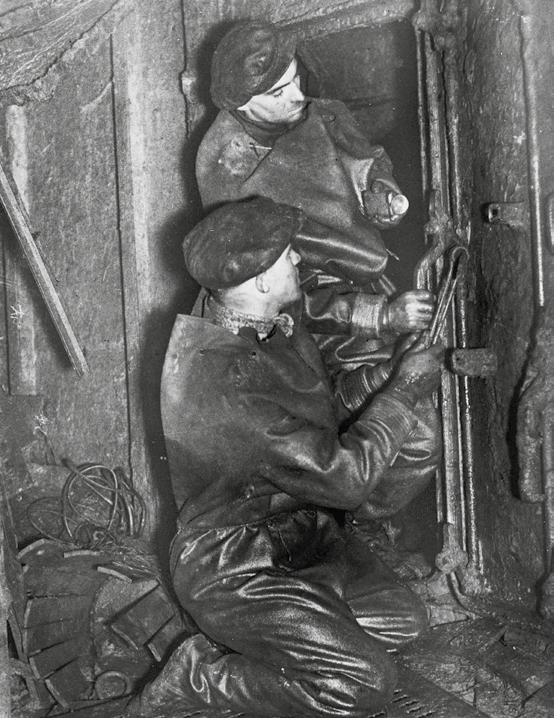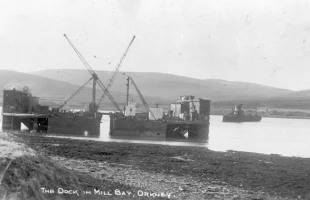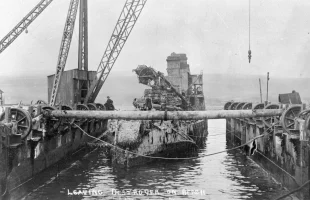World War I – Salvage and Diving

Between the wars the sunken German Fleet was salvaged by the firms Cox & Danks and Metal Industries Ltd., using compressed air to lift the wrecks.
After World War I, the Admiralty had declared that no effort to salvage the German High Seas Fleet would be made and that it could rust in Scapa Flow. The 22 beached ships had been re-floated and towed away, although the Navy had lost seven of the destroyers when a gale sprang up in the Pentland Firth during the trip to Rosyth. Five sunk in the Firth, one drifted back to Flotta and sank and the other drifted north until it ran aground at Lopness Bay, Sanday, where its remains can still be seen at low tide.
Other destroyers were salvaged and broken up locally before Ernest Cox, a scrap merchant and engineer, bought 26 destroyers and two of the big ships.

Cox had never raised a ship before, but it was just the sort of challenge that he delighted in. He has been described as an autocratic and overbearing man, but he was passionate about engineering and expected others to care as much about their work as he did.
His company, Cox & Danks, paid good wages to their workers, cushioning many in Orkney from the harsh realities of the Depression whilst also bringing much needed income to the island economy. Cox set up his HQ at Lyness and prepared to salvage the German Fleet.
The Floating Docks
In the early summer of 1924 a huge floating dock was towed to Scapa Flow to be used by Cox in the raising of the German ships. Ironically it had been seized from Germany by Britain as part of the reparations for the scuttling of the High Seas Fleet. Cox had it cut in two along its length so that it formed two lifting platforms that were L-shaped in section. They were positioned at either side of a sunken destroyer which had wire cables passed underneath by a pair of divers.
At low water the winches on the floating docks were turned so that the slack on the wires were taken up. As the tide rose so did the destroyer, which was brought into shallow water and the process was repeated until the destroyer was beached.

Cox raised his first destroyer, V 70, on 31st July 1924. It proved to be unlucky, as most of the valuable metal had been plundered by divers and the price of scrap had fallen. Cox patched it up, renamed it Salvage Unit No. 3, and used it as a workshop. By using this method of lifting Cox could raise the destroyers, but there was still the problem of raising the big ships.
Cox had tried to lift the SMS Hindenburg by sealing all openings in her then pumping out the water, but this proved unsuccessful as the ship listed dangerously. Although she was the only one of the big ships to lie on an even keel, the Hindenburg proved to be one of the most difficult ships to salvage.
Another method had to be found to raise the capsized battleships, which Cox solved with his ingenious ability to work out engineering problems. Cox joined together boilers from the destroyers to form huge metal tubes. These were fitted with hatches to provide a seal, and a metal ladder was fitted onto both the outside and inside.
These constructions were giant air locks, which were towed to a ship and fastened to the upturned hull.
Working inside the air lock a hole was cut through the bottom of the hull and compressed air was pumped into the ship. When the air had forced the water out of the ship it was divided into a number of watertight compartments, each with its own air lock. Any holes in the ship, including broken portholes and pipes, were patched with cement.

When this work was over the ship was pumped full of compressed air until it rose from the seabed. By pumping more air into a single compartment the ship could be stabilized and kept afloat evenly.

SMS Derfflinger
John Tulloch from Cava found work as a young man on the salvaging SMS Moltke.
“Thousands of minor holes were discovered that had to be patched and because [of] the seaweed on the outside it was easier to patch them from inside, so gangs of men had to enter through the air locks with acetylene cutters and patches to do the job.
Very few of us had worked under air pressure before and it was a weird experience the first time we went down but after a few days we got used to it. The pressure was not high, about twenty pounds to the square inch, but it made our ears crack going up and coming down, however we soon learned to counteract that and when we got down our four hours passed quite happily.”

“Inside the wreck there was a wilderness of oil covered machinery, pipes, companionways and other obstructions all topsy-turvy as, of course, the ship was bottom side up. This wilderness became worse as we cut our way through bulkheads and made paths to get where we wanted to go. Day by day we burned, cut and patched, all the time getting further into the bowels of the ship.
Electric lights were strung across the wreck above our heads and as we cleared our way these were extended from compartment to compartment but they never really gave out much light. Outside the radius of the lights the interior was dark and gloomy, full of traps and hidden openings, hatches, ventilator shafts and other holes that had to be carefully watched for all the time.
The realization that the sea was being held back all around us by the hull of the ship only made things very eerie at times. If something went wrong there was not much chance of escape except [if] one was near the air lock.
Every day our work progressed further and further away from the air locks and the walk to and fro became tedious at times as we were usually clothed in old canvas diving suits without the helmets and boots.”

“One day, whilst a gang of us were down cutting and patching away as usual, sealing the hull into three sections, the unexpected happened. We had been working for about an hour when the electric light bulbs commenced to become hazy, as if they were being steamed up. I stopped what I was doing and gazed around.
Someone started yelling, “Drop tools and run for the airlock”. I had already dropped everything and commenced to make for the lock. The lights started to flicker until they gave one final flicker and went out. Darkness descended around me. With outstretched arms I stumbled on and found a man hole; a gale force wind tore through it and swept me with it. Men were shouting everywhere. Suddenly there was a movement in the hull and I sprawled on my face amongst the wreckage.
Clawing myself upright again I felt for a torch that I had in my pocket. It did not take me many seconds to switch it on and see where I was, but by this time terror had gripped me and like the rest of the men I was yelling also. Another blast of wind lifted me off my feet and dashed me against a bulkhead. Old pipes and other protruding pieces of metal tore at my suit and gashed my hand and face and I was crying like a child; after all I was still young and life was sweet.
Just then the lights went on again and we all saw where we were; the air lock entrance was near and everyone rushed for it. Willing hands helped one another in until a count of heads showed that we were all there. Then the hatch was smartly closed and the valve opened to let the air out.”

Moving the raised battleships
The raised battleships were towed upside down to Rosyth Naval Base to be broken up for scrap. Salvage work was brought to a halt in 1939 by the outbreak of WW2, but was resumed in the 1950s.
Once a ship had been raised it was towed into shallow water at Lyness during high tide. The team set about cutting as much scrap from the wreck as possible, both to gain some much needed cash and to lighten the ship for its final voyage. The large battleships were towed upside down to the Naval Dockyards at Rosyth near Edinburgh where they were broken up.
For the voyage the huge airlocks were replaced by small ones which stopped the air escaping. Huts to house the generators and air pumps were built on the upturned hull of the ship, as were accommodation huts for the crew.
he ship’s superstructure posed a problem as it could get caught on the seabed. Cox solved this by having a ship’s boiler filled with concrete fastened to the seabed. The raised battleship was positioned with its conning tower directly over the boiler and allowed to sink, forcing the tower up into the ship. It was raised once more by pumping in compressed air.
Ernest Cox had salvaged 26 destroyers between July 1924 and May 1926. He had also raised seven battleships of over 20,000 tons between 1926 and 1932, some lying in as much as 100 feet (30m) of water. He was faced with problems along the way that had never been encountered before in the world of salvage. He met these challenges with grim determination and a keen mind that could overcome any situation. One example of this was when the General Strike of 1926 forced up the price of coal. Cox overcame the problem by cutting through the exposed hull of the battlecruiser SMS Seydlitz to gain access to her full coal bunkers, giving him his very own coal mine in Scapa Flow.

Cox was forced to abandon the salvage work in Scapa Flow in the early 1930s due to the fall in scrap metal prices. His work was continued by Metal Industries Ltd. who employed the same workforce and base at Lyness. Cox had actually made a loss in his salvage work, although the scrap side of his business was highly successful.
Metal Industries Ltd. raised most of the remaining ships until work was brought to a halt by the outbreak of World War II. The firm remained at Lyness throughout the war years as salvors for the Admiralty.
Nundy Marine Metals
Arthur Nundy, who had worked as a diver and foreman rigger for Cox & Danks and Metal Industries, set up Nundy Marine Metals in 1955 and restarted salvage work, lifting non-ferrous metal and armour plate from
the remaining wrecks.
He even obtained a salvage contract from the Admiralty for HMS Vanguard, a WW1 ship which had blown up at anchor in 1917, with great loss of life. Divers wearing hard helmets reported seeing human bones mixed with the coal and oil sludge as they worked among the mangled wreck.
HMS Royal Oak, torpedoed in Scapa Flow on 14 October 1939, was considered for salvage at the same time, but public outcry at the idea quickly put a stop to the plan. HMS Vanguard, lost through accident rather than enemy action, was obviously not held in the same esteem. Both wrecks were eventually afforded legal protection in 1986 under the Protection of Military Remains Act.
In 1971 Nundy Marine Metals was bought by Dougal Campbell and David Nicol, who continued salvage operations until 1977. By that time most of the accessible heavy armour plate had been removed and falling scrap prices made further operations uneconomic.
Steel made prior to the discovery of nuclear fission has negligible radiation activity, whereas steel manufactured after 1945 absorbs nuclear fission products from the atmosphere. This makes pre-nuclear steel invaluable in processes where precise measurements of very low radiation activity are necessary, as it can be used to shield experiments or medical processes from background radioactivity.
Steel salvaged from Scapa Flow has been used in space exploration and medical research. In particular, an Edinburgh company called Nuclear Enterprises Ltd. used 2,000 tons of steel from five pre-1945 ships to build large medical systems and associated shielded enclosures in hospitals all over the world.
Scapa Flow Museum is currently closed for a major refurbishment project, funded by Orkney Islands Council, National Lottery Heritage Fund, Historic Environment Scotland, Highlands and Islands Enterprise, Museums Galleries Scotland, Scottish Natural Heritage and the Orkney LEADER fund. The project includes carrying out essential repairs to Pumphouse No. 1 and building an extension to house a new gallery, visitor facilities and café.
Visitors can virtually explore the buildings and former exhibitions at www.hoydrone.com/museum, a 3600 photo record of the main site museum site.
The Island of Hoy Development Trust website www.hoyorkney.com has a large Wartime Heritage section focusing on the WW2 history of Hoy.





















